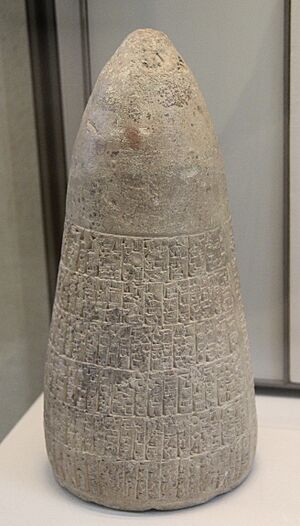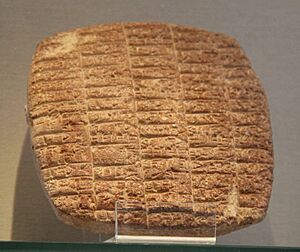Gu-Edin facts for kids
Gu-Edin was a rich, flat area of land in ancient Sumer, which is now part of modern-day Iraq. It was located between two important cities, Umma and Lagash. Both cities wanted to control Gu-Edin because its land was very good for farming. This led to a long conflict known as the Umma-Lagash war. The fight over this land lasted for about 150 years!
Early History of Gu-Edin
Long ago, the king of Kish, named Mesilim, tried to help Umma and Lagash make peace. He decided where the border of Gu-Edin should be. He also set rules for how they could use a special canal that brought water to the land for farming. This agreement was written down on a tall stone monument called a stele. However, the people of Umma still felt that Lagash had an unfair advantage from this agreement.
The Reign of Eannatum
Later, a ruler (called an énsi) from Umma, named Ush, attacked Gu-Edin. He took valuable things from the land. The ruler of Lagash at that time was Eannatum. He believed Gu-Edin belonged to Lagash's god, Ninĝirsu. Because Ush attacked, a big war started between the two cities.
Eannatum fought back, and Umma was badly beaten. After the war, Ush was either no longer the ruler or had died.
A New Peace Treaty
A new peace agreement was made between Eannatum and Ush's successor, Enakalle. This treaty officially said that Gu-Edin belonged to Lagash's god, Ninĝirsu. To mark the new border, a deep canal was dug. Two stone monuments were also put in place: the old stele from King Mesilim and a new one.
This treaty was very important. It included promises and the building of temples to seal the agreement. It also set aside a piece of land that no one officially owned. This land was like a buffer zone between the two cities. If Umma wanted to grow barley in a certain part of Gu-Edin, they had to pay Lagash for it, like a loan with interest. This meant Umma could use the land, but they had to pay rent. However, Umma often did not pay what they owed.
Later Conflicts
Gu-Edin was attacked by Umma at least two more times during the rule of Eannatum's son, Entemena. First, a ruler named Ur-Lumma attacked, and then his successor, Illi, attacked. Entemena said that the first attack was easily defeated. The second attack by Illi was not successful for very long.
Finally, around 2350 BCE, Lagash was conquered by Lugalzagesi, who was the king of Umma. This ended the First Dynasty of Lagash. Ancient clay tablets have been found that tell sad stories about Lagash falling to Lugalzagesi during the time of its ruler, Urukagina. Lugalzagesi then went on to conquer all of Sumer. But later, he himself was defeated by Sargon of Akkad.
See also




